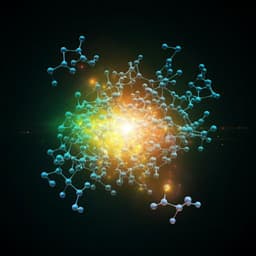
Engineering and Technology
Sustainable biomimetic solar distillation with edge crystallization for passive salt collection and zero brine discharge
M. A. Abdelsalam, M. Sajjad, et al.
Discover an innovative solar desalination device that mimics mangroves, designed to generate freshwater and efficiently collect salt without generating brine. This remarkable technology, developed by Mohamed A. Abdelsalam, Muhammad Sajjad, Aikifa Raza, Faisal AlMarzooqi, and TieJun Zhang, achieves impressive efficiency and sustainability.
~3 min • Beginner • English
Introduction
The study addresses the global challenge of clean water scarcity and the environmental drawbacks of conventional desalination (high energy consumption, fossil-fuel dependence, greenhouse gas emissions, and brine discharge). Direct solar vapor generation (SVG) offers a renewable pathway but suffers from salt accumulation on photothermal layers, which degrades light absorption and evaporation performance. Existing passive salt-mitigation strategies (e.g., Janus structures, designs that allow back diffusion of salt) often return salt to the reservoir, missing the opportunity for salt harvesting and raising salinity. The research question is how to design a sustainable, scalable SVG system that simultaneously produces freshwater and harvests salt with zero liquid discharge while maintaining stable, high efficiency. The proposed solution is a mangrove-inspired solar vapor generator and crystallizer (SVGC) that promotes edge-preferred crystallization to keep the central evaporation zone clean, enabling continuous operation and passive salt collection.
Literature Review
The paper surveys conventional desalination technologies (reverse osmosis and thermal processes) highlighting their energy intensity and environmental impacts, including greenhouse gas emissions and harmful brine discharge. It reviews interfacial SVG advancements leveraging localized heating and improved photothermal materials and structures. Passive salt-mitigation approaches (Janus hydrophilic/hydrophobic structures, direct contact evaporators allowing salt back-diffusion) can maintain clean interfaces but typically return salt to the source, increasing salinity and losing the benefit of salt recovery. Biomimetic designs inspired by halophytes, especially mangroves with salt secretion and capillary-driven water transport, have been explored for salt regulation. Prior works include 3D evaporators for high salinity desalination via localized crystallization, umbrella evaporators for salt harvesting, and synthetic mangrove concepts for capillary-driven desalination. However, a compact, corrosion-resistant, scalable device that couples efficient light absorption, robust wicking, edge-directed crystallization, passive salt peeling, and zero liquid discharge under day–night cycling remains needed.
Methodology
Device concept and materials: The SVGC mimics mangrove leaves and stem using a chemically oxidized nanostructured titanium mesh (TiO2/Ti). The superhydrophilic, corrosion-resistant mesh provides capillary-driven water supply and serves as a broadband solar absorber (>90% absorptance from 250–2000 nm when wetted). The leaf acts as the evaporation surface; the stem provides passive unidirectional wicking from the reservoir.
Material processing and characterization: Titanium mesh was cleaned and hydrothermally etched in 1.0 M NaOH to grow nanostructured TiO2. Morphology was characterized via SEM (Nova NanoSEM 650). Optical absorption was measured by UV–vis–NIR spectrophotometry (PerkinElmer LAMBDA 1050). Wettability assessed via contact angle (Kyowa DM501). Infrared (IR) imaging (FLIR E95) tracked water propagation/wetting fronts. The superhydrophilic mesh exhibited fast wicking; IR-tracked saline (24 wt.% NaCl) imbibition reached 52 mm in 8 s along warp wires. Water supply rate versus stem height and anisotropy (warp vs shute wires) was quantified.
Experimental setups: A lab-scale setup used a solar simulator (Sciencetech) at 0.5, 1.0, and 1.5 suns; an analytical balance (RADWAG, 0.01 g) monitored mass loss. A foam-insulated beaker served as reservoir; thermocouples with NI DAQ measured leaf temperatures; irradiance measured with an EKO solar meter.
Design optimization: Single-leaf devices with identical projected illuminated area were tested at leaf tilt angles of −30°, 0°, and +30° using 12 wt.% brine under 1 sun for 12 h. The +30° tilt achieved higher salt resistance and thermal efficiency (75%) versus 60% (0°) and 62% (−30°), and was adopted subsequently. Stem height (short vs long, same projected area) was varied under 1 sun using 3.5 wt.% brine for 24 h with day/night cycling; short stems maintained stronger wicking and better performance.
Performance testing: Evaporation flux was measured in dark and under simulated sunlight for DI water and saline solutions (3.5, 7, 12, 17 wt.%). Day–night periodic operation involved 12 h illumination at 1 sun followed by 12 h dark over multiple cycles and days. Durability was tested over four consecutive day–night cycles. Scaling was explored with double-layered leaf arrangements and with four-device outdoor tests using real seawater (4.2 wt.% salinity) for freshwater collection.
Salt harvesting and peeling: Edge-preferred crystallization was promoted by leaf geometry and mesh micro/nanostructure, keeping central areas clean during daytime evaporation. During the night, strong rewetting dissolved the interface at the salt–leaf contact, allowing gravity-driven passive peeling and salt collection.
Numerical modeling: COMSOL Multiphysics (v5.6) finite-element simulations modeled salt concentration profiles along the porous evaporator, predicting the precipitation-free length fraction (Isat/L) versus bulk concentration. Back-diffusion of salt during dark/re-wetting was modeled; the diffusion coefficient was estimated by matching simulations to experiments at a specific position along the stem (z = 22 mm). Edge effects and spike geometries were analyzed to rationalize localized nucleation and peeling behavior.
Metrics and analyses: Evaporation fluxes were reported per total device area and per top illuminated area. Thermal (solar-to-vapor) efficiency was computed versus irradiance and salinity. IR thermal mapping confirmed localized heating at leaf tops. Inductively coupled plasma analysis quantified cation concentrations (Na+, K+, Mg2+, Ca2+) in distillate versus feed, compared to WHO and OHDC standards.
Key Findings
- Photothermal/evaporation performance:
- Absorptance: >90% across 250–2000 nm for wetted TiO2/Ti mesh.
- Dark evaporation flux (kg m−2 h−1): DI 0.09; 3.5 wt% 0.076; 7 wt% 0.072; 12 wt% 0.062; 17 wt% 0.060.
- Under simulated irradiance (3.5 wt% unless noted): flux (total area basis) 0.38 (0.5 sun), 0.61 (1 sun), 0.98 (1.5 suns). On top-area basis: 0.76, 1.22, 1.92 kg m−2 h−1, respectively.
- Under 1 sun across salinities (total area basis): DI 0.62; 3.5 wt% 0.60; 7 wt% 0.56; 12 wt% 0.54; 17 wt% 0.48 kg m−2 h−1 (top-area basis: 1.24; 1.20; 1.12; 1.08; 0.96 kg m−2 h−1).
- Thermal efficiency: ~97% (0.5 sun), 94% (1 sun), 88% (1.5 suns). At 1 sun: DI 98%; 3.5 wt% 94%; 7 wt% 86%; 12 wt% 77%; 17 wt% 63%.
- Day–night periodic operation (1 sun for 12 h, dark for 12 h):
- Daytime evaporation remained stable due to edge crystallization keeping central leaf area clean.
- Night flux dropped to ~0.1 kg m−2 h−1; rewetting promoted passive salt peeling and leaf recovery.
- Salt peeling rates (g m−2 h−1): 3.5 wt% 7.5; 7 wt% 11.6; 12 wt% 33.2; 17 wt% negligible. Corresponding daytime evaporation fluxes: 0.48, 0.36, 0.32, 0.26 kg m−2 h−1.
- At 17 wt% salinity, dark evaporation (~0.094 kg m−2 h−1) exceeded that of 7–12 wt% due to porous, hydrophilic salt increasing effective evaporation area in the dark.
- Patchy salt enhanced dark evaporation: stem with salt patches evaporated 0.16 g h−1 vs 0.10 g h−1 for clean stem (1.6× increase) under absolute dark conditions.
- Outdoor scalability and water quality:
- A four-device outdoor setup using real seawater (4.2 wt%) produced 2.2 L m−2 day−1 of freshwater, sufficient for individual daily drinking needs.
- Distillate cation concentrations (mg L−1): Na+ 16.84, K+ 1.49, Mg2+ 1.15, Ca2+ 4.29—about four orders of magnitude lower than feed; met WHO and OHDC drinking water standards.
- Design optimization:
- Leaf tilt: +30° tilt yielded higher salt resistance and thermal efficiency (75%) vs 0° (60%) and −30° (62%).
- Stem height: shorter stems provided stronger wicking and better performance.
- Modeling and transport:
- COMSOL predicted precipitation-free length fractions (Isat/L) at c/Csat=1 (no edge effect): 3.5 wt% 0.89; 6 wt% 0.77; 12 wt% 0.60; 18 wt% 0.40; 24 wt% 0.11, matching experimental precipitation trends.
- Estimated back-diffusion coefficient during rewetting: ~1.15×10−9 m2 s−1 (≈ one order higher than bulk ~1.5×10−10 m2 s−1).
- Structural effects on crystallization/peeling:
- Spikes on leaf edges favor nucleation/crystallization (higher local evaporation, thinner films, higher supersaturation), but hinder peeling; non-spike edges enable more effective dissolution at the interface and gravity-driven peeling.
Discussion
The SVGC addresses the dual challenge of efficient solar-driven evaporation and brine management by guiding salts to crystallize at leaf edges while maintaining a clean, light-absorbing central area. This design sustains high solar-to-vapor efficiencies (≈94% at 1 sun with 3.5 wt% saline) and stable fluxes across salinities. Day–night cycling leverages natural rewetting to dissolve the salt–leaf interface and enable gravity-driven peeling, achieving passive salt collection and zero liquid discharge without external energy input or moving parts. The discovery that porous, hydrophilic salt patches enhance dark evaporation clarifies that daytime performance losses under heavy crystallization stem primarily from optical reflection rather than pore blocking—informing future designs to manage salt reflectivity while exploiting capillary transport through salt. Modeling and experiments consistently show supersaturation developing toward the leaf edges and later along the stem at higher bulk salinities, explaining observed precipitation patterns and validating edge-preferred crystallization. The scalable, corrosion-resistant TiO2/Ti mesh platform, combined with multilayer leaf arrangements, demonstrates practical potential, as evidenced by outdoor tests producing potable water meeting WHO and OHDC standards.
Conclusion
The study introduces a scalable, mangrove-inspired SVGC that couples high-efficiency interfacial solar evaporation with edge-directed crystallization for passive salt harvesting and zero brine discharge. Using superhydrophilic nanostructured TiO2/Ti meshes, the device sustains ≈94% solar-to-vapor efficiency at 1 sun (3.5 wt% saline), achieves stable operation over day–night cycles via passive salt peeling, and produces 2.2 L m−2 day−1 of potable water from real seawater with ion concentrations meeting WHO/OHDC standards. Modeling clarifies supersaturation-driven edge crystallization, and experiments reveal that patchy salt can enhance dark evaporation while compromising optical absorption under light. The compact, multilayer, and modular design supports scalability and efficient land use.
Future work could optimize edge geometries to balance crystallization and peeling, tailor surface optics to mitigate salt-related reflectance under illumination, enhance wicking and thermal management for higher irradiances, and validate long-term field performance across diverse climates and feedwaters, including high-salinity brines.
Limitations
- Performance declines with increasing salinity: evaporation flux and thermal efficiency decrease as bulk salinity rises; at 17 wt% solutions, salt peeling is negligible and some central-area crystallization occurs.
- Optical losses due to salt: daytime efficiency drops mainly from light reflection by white salt deposits; while salt is beneficial for dark evaporation, it hampers photothermal conversion under illumination.
- Geometric trade-offs: edge spikes promote crystallization but hinder peeling; non-spike edges peel more readily, requiring design optimization for reliable harvesting.
- Wicking dependence on geometry: water supply rate diminishes with stem height and is anisotropic (warp vs shute wires), constraining form factors.
- Reliance on day–night cycles: passive peeling depends on nighttime rewetting; environments without sufficient diurnal variation may require alternative triggering (e.g., controlled flushing or humidity cycling).
- High-salinity operation: at very high salinities, precipitation can encroach on central areas, potentially necessitating active management or modified architectures.
Related Publications
Explore these studies to deepen your understanding of the subject.







